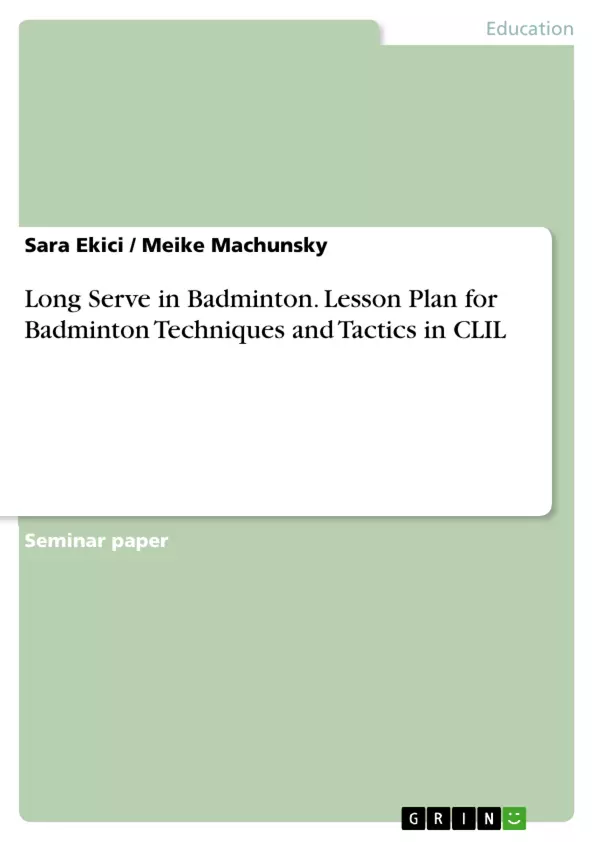By the example of the topic “Badminton – the long serve” we will show the importance and relevance of CLIL classes in physical education. Here in this case, not a typical American or English sport, we show its relevance and possibilities for vocabulary training and to learn how to describe movements in English and how to correct mistakes and talk about the actions and rules. Intercultural learning is possible with nearly every sport and with its specialities P.E. lessons are perfect for CLIL.
First the aims of CLIL classes for the subject of physical education are described. Then, in the end it is important to see that, opposed to general assumptions, there are several CLIL aspects that can be easily implemented in physical education classes.
Table of Contents
- Introduction
- Aims of "CLIL" for the subject Physical Education
- Teaching Plan for the Subject Physical Education in "CLIL":
- Learning objectives
- Didactical Analysis
- Technical Analysis
- Methodical Analysis
- What is typically CLIL in this lesson?
- Lesson plan
- Reflexion
- Conclusion
- References
- Appendix
Objectives and Key Themes
This paper examines the implementation of Content and Language Integrated Learning (CLIL) in physical education classes, specifically using the example of badminton. The goal is to demonstrate the value and relevance of CLIL in physical education by showcasing its benefits for vocabulary training, movement description, error correction, and intercultural learning. Key themes explored in the paper include:- The rationale for incorporating CLIL into physical education classes.
- The aims and objectives of CLIL in physical education, encompassing both language and subject-specific learning goals.
- The specific ways in which CLIL can be implemented in physical education, including the use of vocabulary, movement descriptions, and intercultural learning.
- The importance of using appropriate materials and resources to support language learning in physical education.
- The potential for CLIL to enhance student communication and learning experiences in physical education.
Chapter Summaries
Introduction:
This chapter introduces the concept of CLIL in physical education and highlights the recent emergence of interest in this approach. It also discusses the historical context of CLIL in Germany and its prevalence in other subjects, contrasting with its limited application in physical education. The chapter then establishes the specific example of badminton as a case study for exploring the potential of CLIL in physical education.Aims of "CLIL" for the subject Physical Education:
This chapter outlines the aims of CLIL in physical education, dividing them into three levels: sporting goals, cultural language use, and foreign language competency expansion. It emphasizes the importance of using everyday language, the role of the teacher in providing clear instructions, and the need for diverse materials and resources to support language learning in physical education. The chapter further discusses the opportunities for students to actively engage in language use and develop communication skills through various activities and scenarios within the physical education context.Teaching Plan for the Subject Physical Education in "CLIL":
This chapter delves into the practical implementation of a CLIL lesson plan for badminton techniques and tactics. It includes detailed sections on learning objectives, didactical analysis, technical analysis, methodical analysis, and a specific lesson plan outline. This chapter provides a concrete example of how CLIL principles can be applied in a physical education setting.Conclusion:
This chapter summarizes the key points of the paper and reinforces the importance of CLIL in physical education. It highlights the benefits of this approach for students, teachers, and the overall learning environment. This chapter is not included in this preview.Keywords
This paper focuses on the topic of CLIL in physical education, examining its relevance and implementation. Key terms and concepts include CLIL, physical education, bilingual education, vocabulary training, movement description, intercultural learning, teaching materials, and lesson planning. These concepts are further explored through the specific example of badminton.- Quote paper
- Sara Ekici (Author), Meike Machunsky (Author), 2008, Long Serve in Badminton. Lesson Plan for Badminton Techniques and Tactics in CLIL, Munich, GRIN Verlag, https://www.grin.com/document/137844



